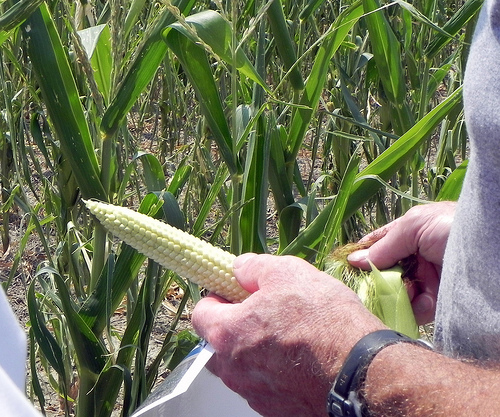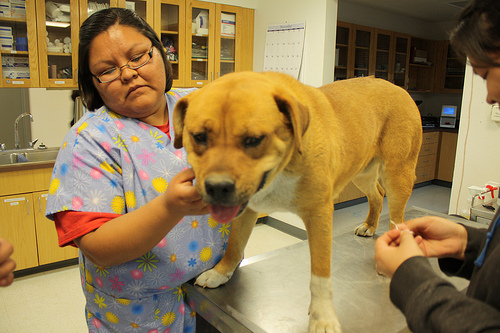
Secretary Vilsack receives the National Energy Leadership Award from the National Biodiesel Board. The award is given periodically to individuals who demonstrate exemplary vision and leadership in development of the renewable fuels industry. Pictured left to right are Ed Ulch, Governing Board Member, National Biodiesel Board; Secretary Tom Vilsack; and Joe Jobe, CEO, National Biodiesel Board.
In the days after the Super Bowl it is not unusual for spectators to “Monday morning quarterback” the advertisements, as well as the plays that were called. For the members of two renewable fuels industries, however, there was no disputing the message of the now famous “God made a farmer” ad featuring Paul Harvey. Last week in Las Vegas, the Renewable Fuels Association and the National Biodiesel Board both led off their meetings with this ad before Secretary Vilsack spoke. It became a starting point to discuss the Secretary’s compelling vision for rebuilding the rural economy, furthering efforts to develop advanced new biofuels, and creating more jobs in our small towns to grow and strengthen the middle class. Read more »
Tags: bio-based economy, biofuels, Farmers, FS, Iowa, jobs, Las Vegas, RD, Rural America, Rural Economy, Tom Vilsack
 Economic Growth, Energy, Rural Development
Economic Growth, Energy, Rural Development

Even in the most remote corners of America's countryside, USDA leaves a gentle, but lasting footprint as a champion of locally led, place-based rural economic and community development. You just have to know what you're looking for. USDA photo.
Have you ever been on vacation, but just couldn’t get away from your work? Me too. It seems everywhere I look I see the footprint of USDA Rural Development and its ties to rural revitalization. Because I love my job and the good work USDA is doing, I am thrilled each and every time I see the results of this collaborative work to stimulate economies, modernize infrastructure, and enhance the quality of life in rural America. Read more »

President Barack Obama and Agriculture Secretary Tom Vilsack visited the McIntosh family farm in Missouri Valley, Iowa, on Monday, August 13, 2012 to view the drought stricken crops. The federal government has already taken some steps to ease farmers whose crops are growing poorly this summer, and the administration plans to spend close to $200 million on livestock, officials announced earlier in the day. The Department of Defense is encouraging vendors to buy meat to ease the crisis. USDA photo by Dave Kosling.
USDA and other federal agencies continue to work to address the long term effects of last summer’s historic drought.
In the wake of a series of regional drought conferences with farmers, ranchers, business owners and other stakeholders, USDA is entering into a memorandum of understanding with the Department of Commerce, including the National Oceanic and Atmospheric Administration (NOAA), to improve sharing of data and expertise, monitoring networks, and drought forecasting efforts. The MOU is a direct outcome of the regional conferences. Read more »
Tags: Arkansas, Colorado, Conservation, Department of Commerce, drought, EQIP, Farm Bill, Farmers, Kansas, Nebraska, NOAA, NRCS, Ohio, Ranchers, Tom Vilsack, Washington D.C.
 Environment
Environment
Rob Green’s recent Wall Street Journal op-ed “The cause of higher grocery bills isn’t the drought. It’s the failed federal ethanol policy” fails to take into consideration a host of factors, other than demand for corn, that affect food prices.
In the domestic and global markets commodity, labor, transportation, energy costs, processing, and marketing costs all contribute to what we pay for food in our local grocery store or restaurant. In some cases, factors such as higher oil prices affect one or more of these underlying costs producing higher domestic and world food prices. Read more »

Farmer Doug Goyings examines the drought-damaged corn on his farm in Paulding County, OH on Tuesday, July 17, 2012. USDA photo by Christina Reed.
The 2012 drought dried up more than just crops. For many U.S. farmers, it also dried up savings, material resources, and perhaps saddest of all, hope.
“The drought of course impacted our crop yields tremendously,” said veteran Ohio dairy farmer Leon Weaver. “Corn yields were about 50 percent of normal. Dairymen are exiting this business in droves.”
But for Weaver and nearly one hundred other Ohio, Michigan and Indiana farmers who gathered recently in rural Henry County, Ohio, hope was a commodity worth trading as they shared, in roundtable fashion, their ideas on how to access resources and rise from the dust. Read more »
Tags: Arkansas, Colleen Callahan, Colorado, Department of Commerce, drought, EDA, Farmers, FEMA, Indiana, Michigan, Nebraska, Ohio, Ohio Department of Agriculture, SBA
 Environment
Environment

Navajo Tech Veterinary Technology Program uses NIFA grant to teach students animal care.
This post is part of the Science Tuesday feature series on the USDA blog. Check back each week as we showcase stories and news from USDA’s rich science and research profile.
USDA honors the achievements of American Indians during Native American Heritage Month and year-round. With educational funding and support from the National Institute of Food and Agriculture (NIFA), Navajo Technical College in Crownpoint, N.M., is one of the many tribal colleges and 1994 land-grant institutions doing considerable work in the scientific fields. Read more »





